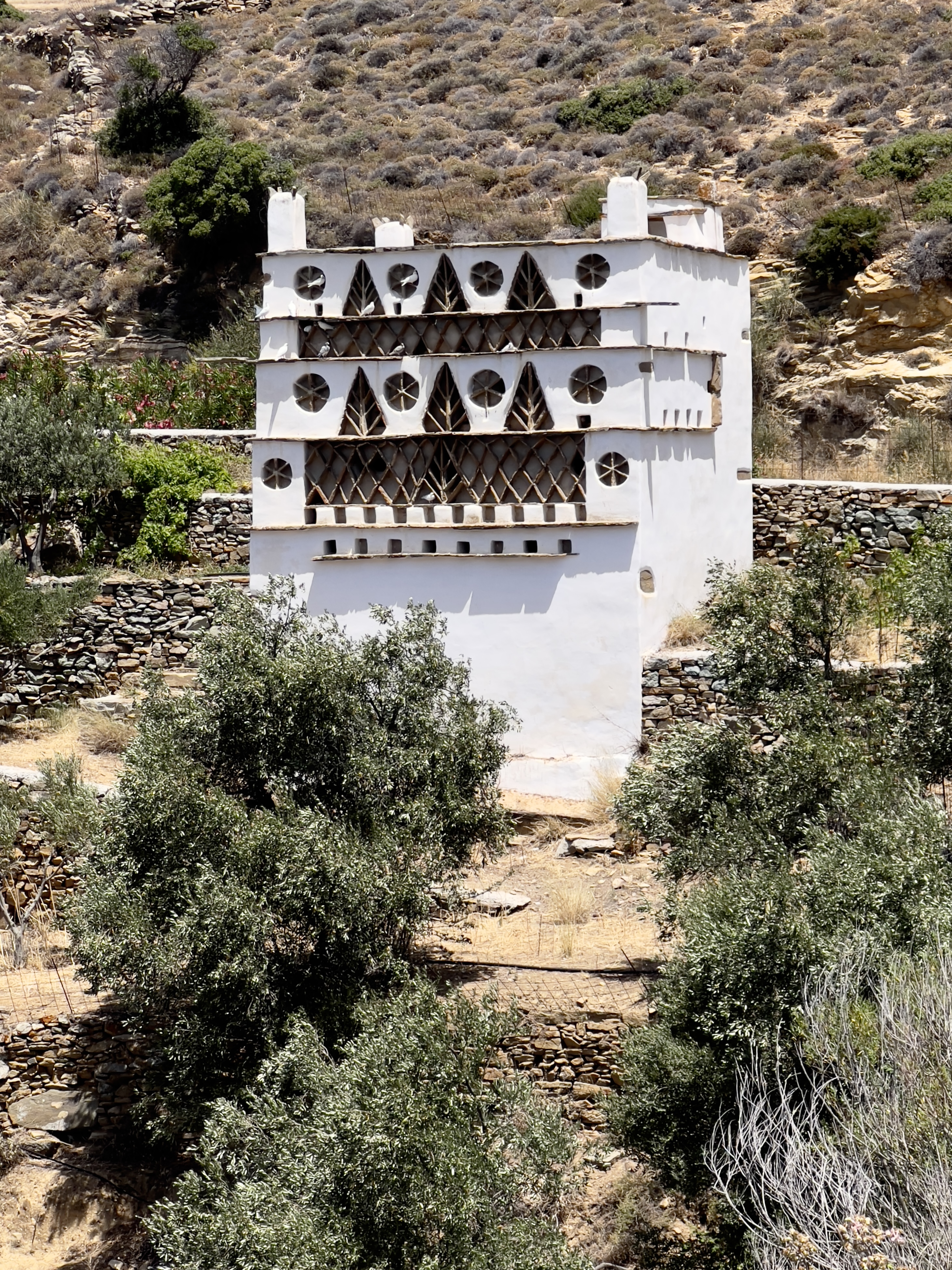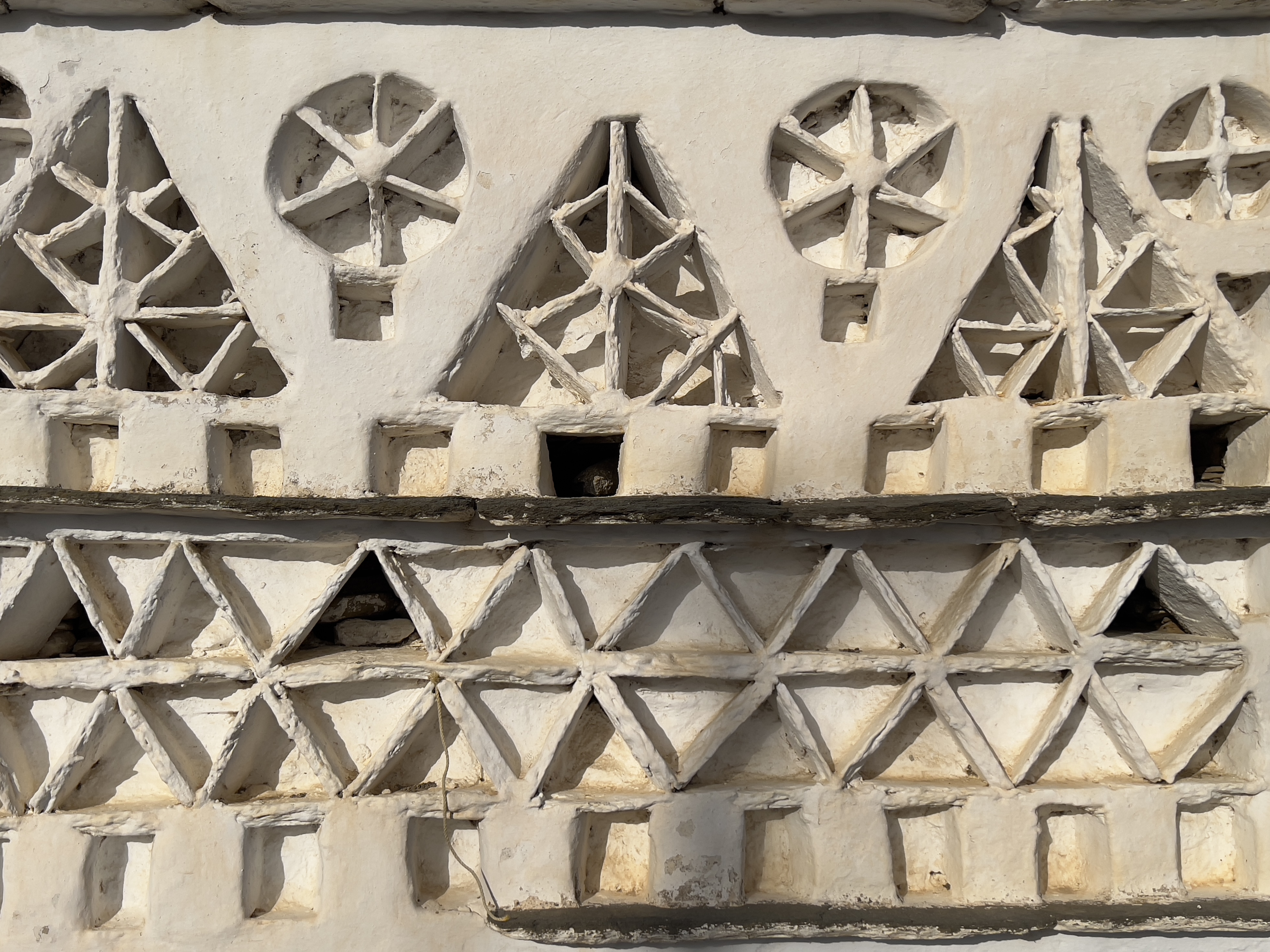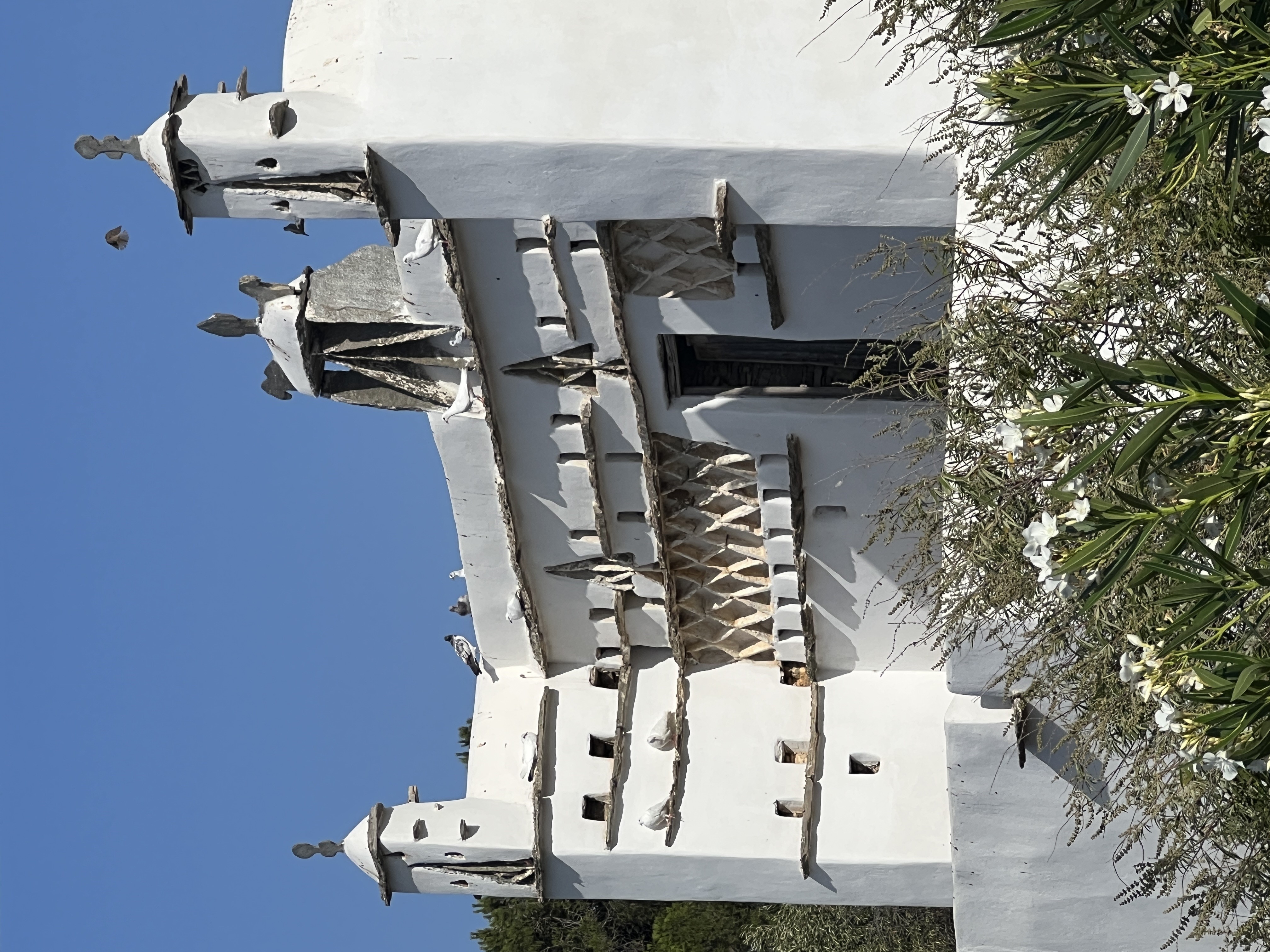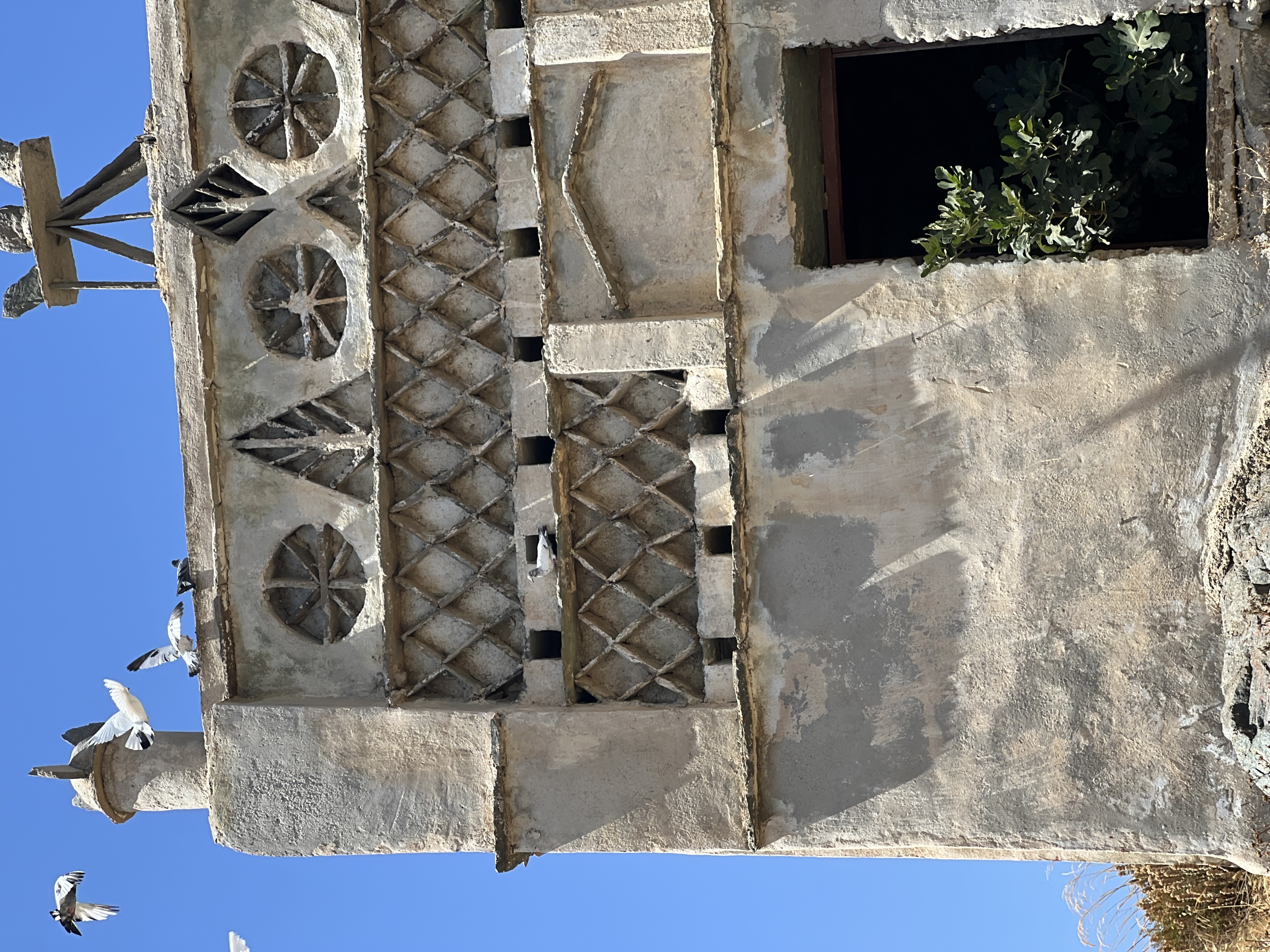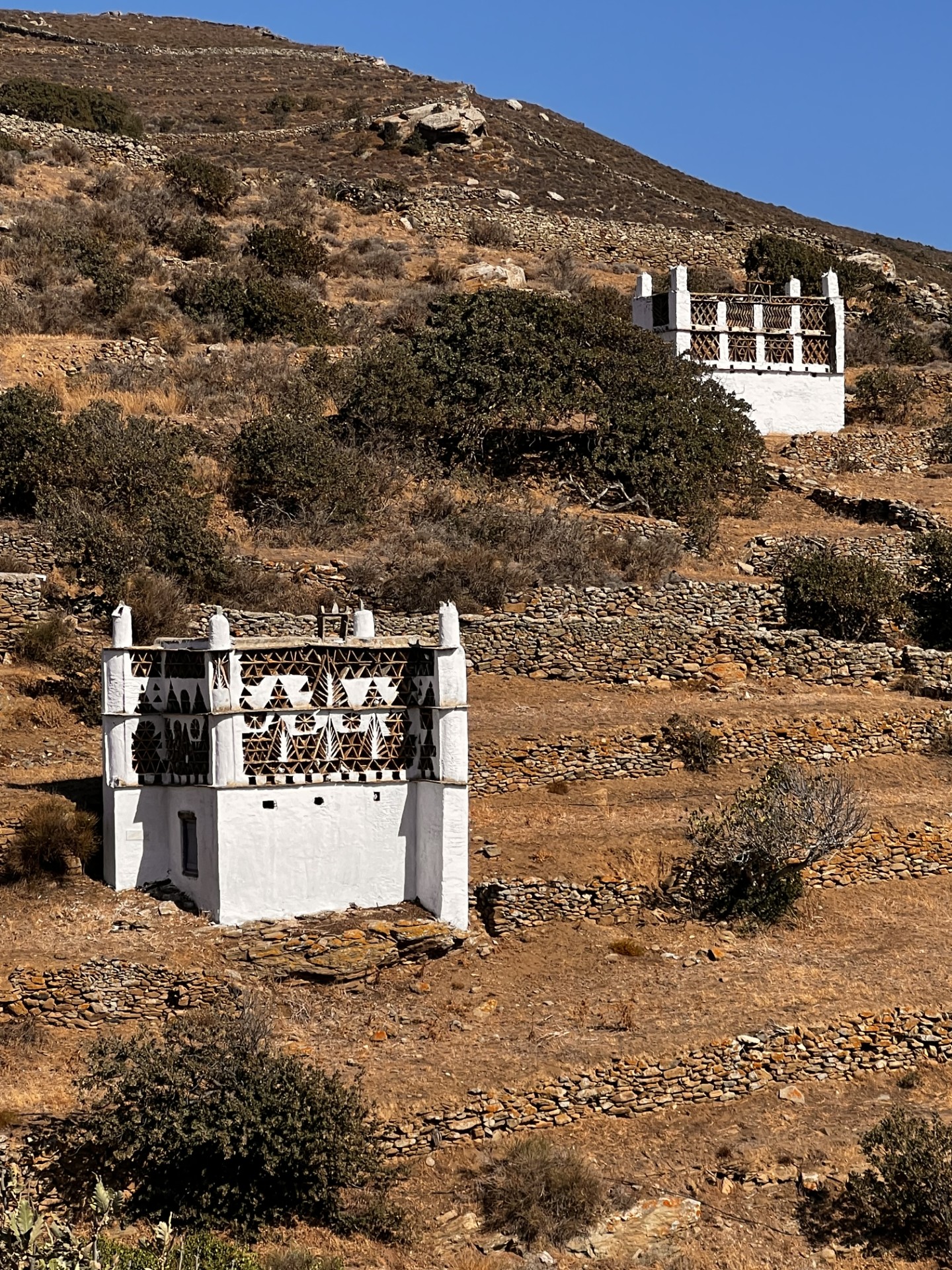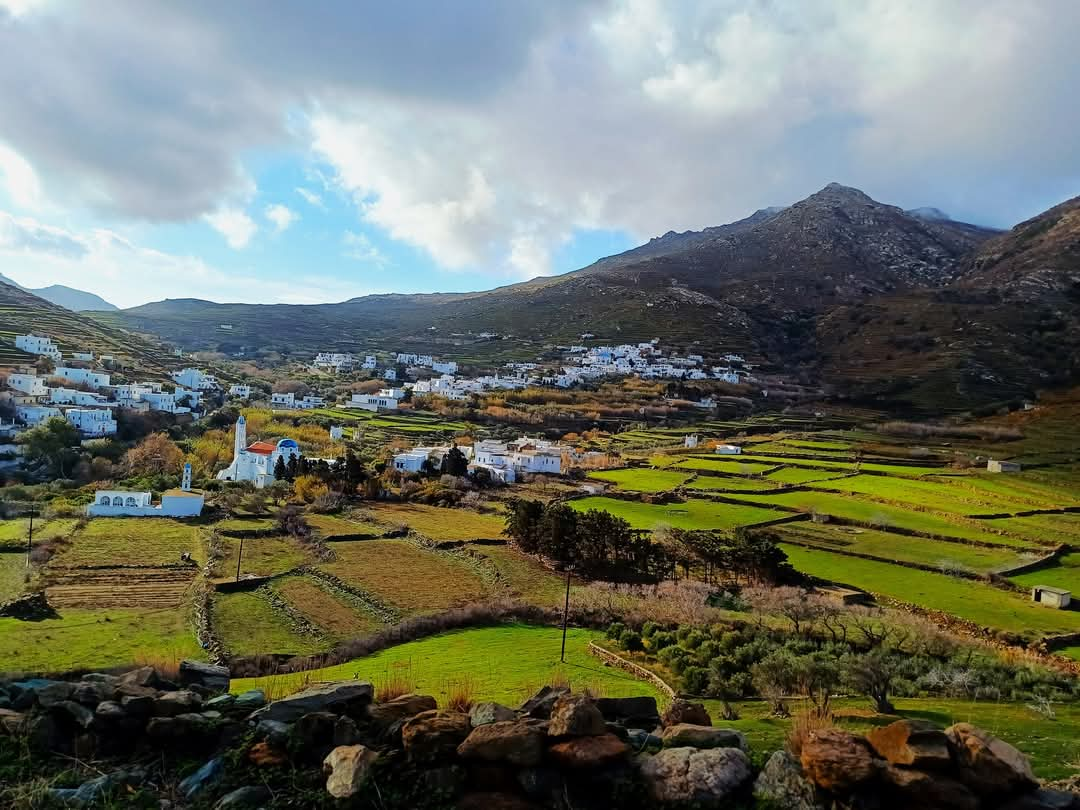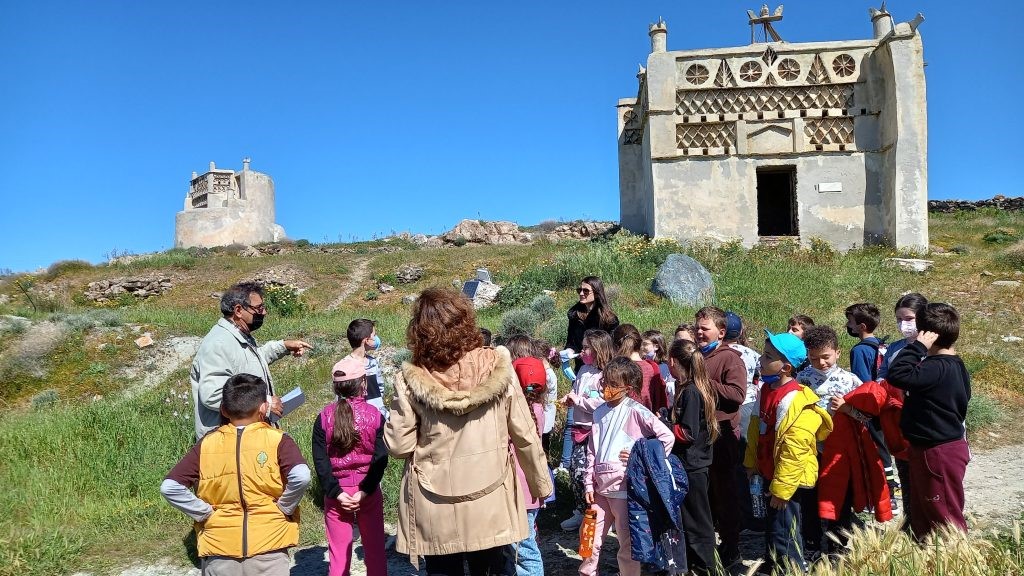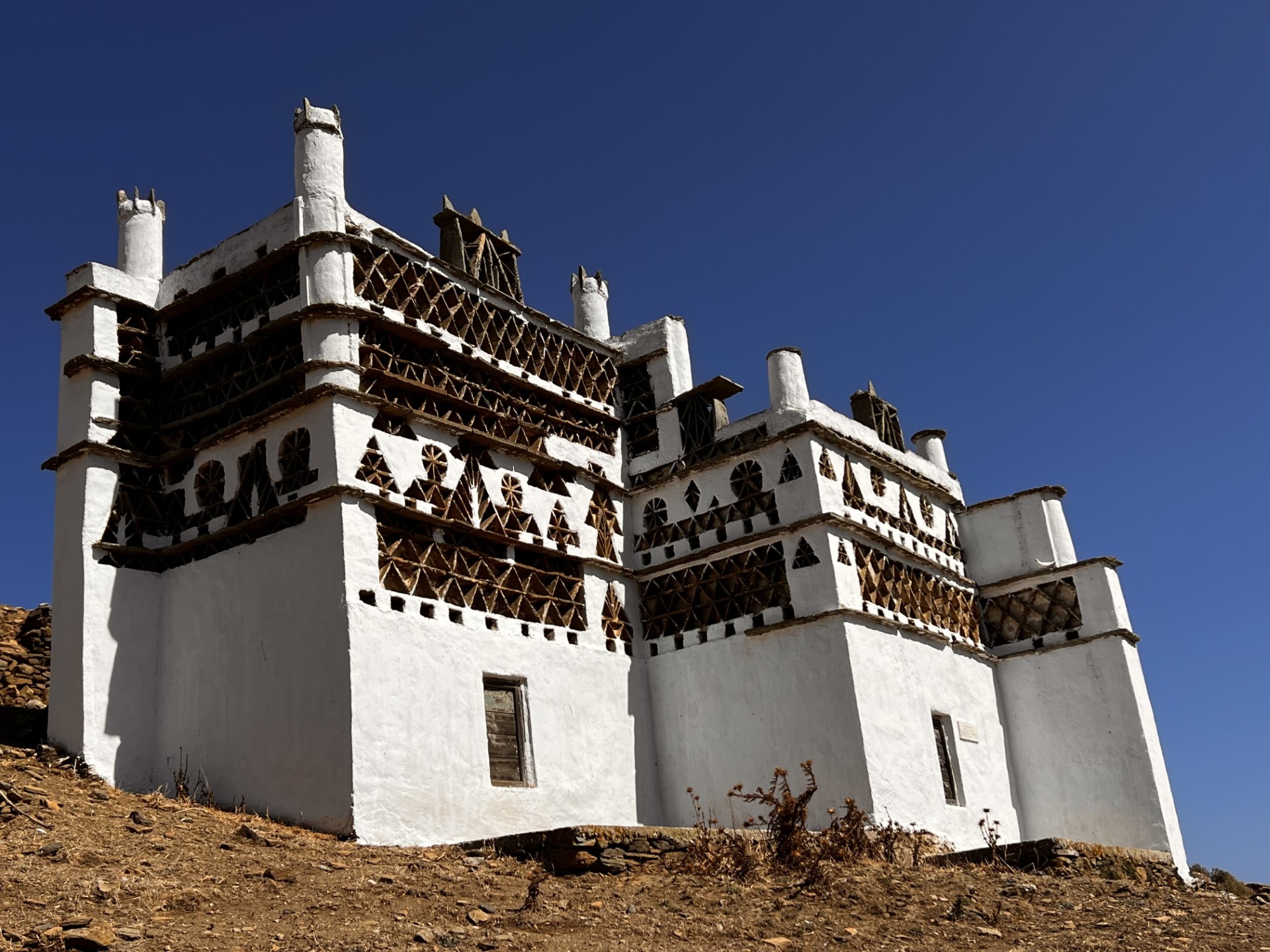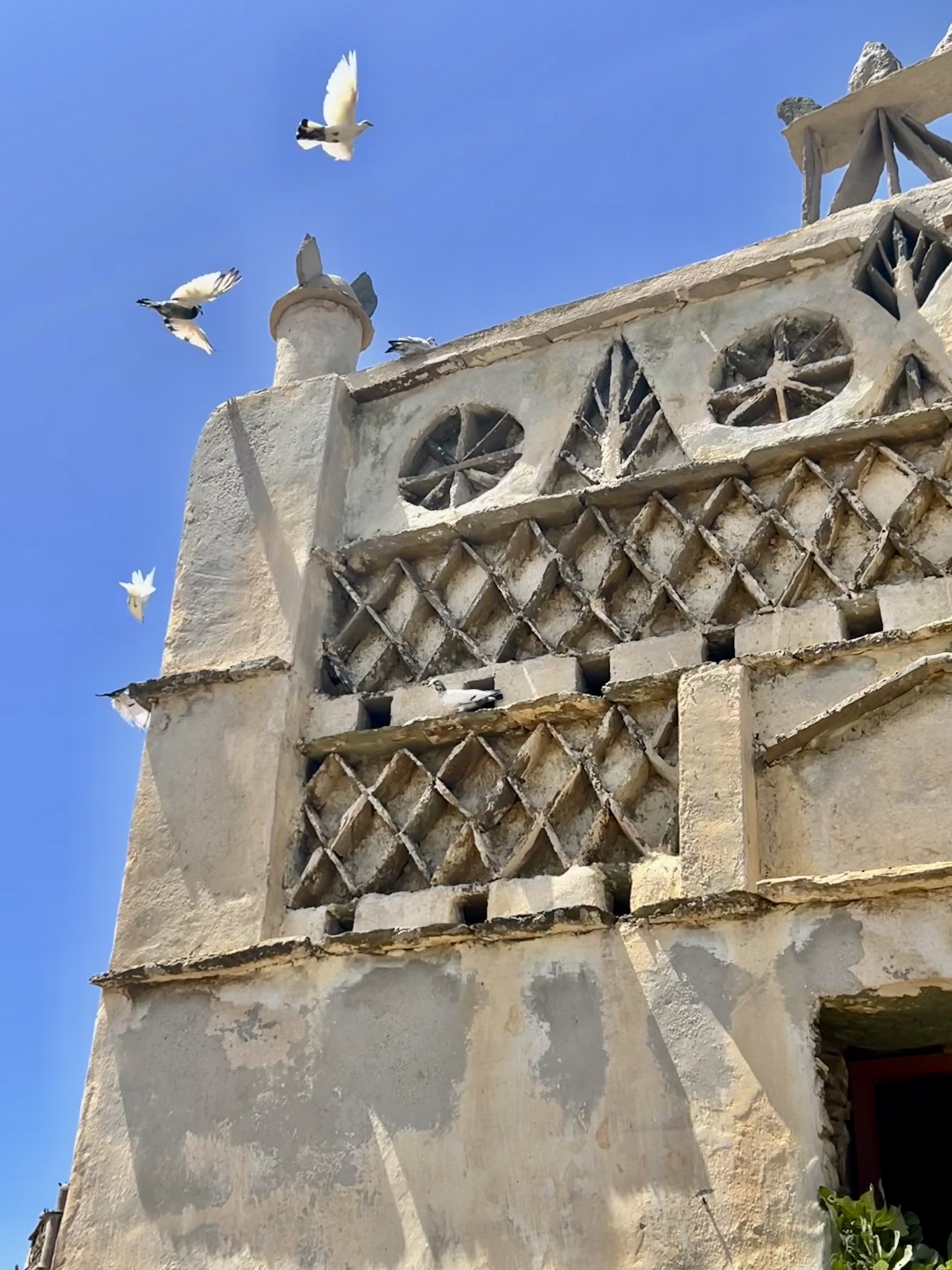Regaining a sense of belonging
Tinos Dovecotes Revival
Tinos Dovecotes Revival: Heritage Reborn
Friends of Greenery in Tinos, Cyclades, initiated a project to save and revive the dovecotes of the island. These unique structures were used to breed pigeons, but with the decline of pigeon breeding they risked disappearing. 148 whitewashed dovecotes, built in local slate stone, beautifully restored are now blending into the landscape, witnesses of a striking rural architecture. The dovecotes are thus back to life, a symbol of pride of local communities and of bonding between men and pigeons.
Greece
Local
Tinos Island, Cyclades, Greece
Mainly rural
It refers to a physical transformation of the built environment (hard investment)
Yes
2024-12-20
No
No
No
As a representative of an organisation, in partnership with other organisations
In an extraordinary collective achievement, the "Tinos Dovecotes Revival” project completed the restoration and maintenance of 148 dovecotes across the island of Tinos. This has been achieved through volunteer work among the owners of the pigeon houses and the interdisciplinary teams of craftsmen, engineers, academics, architects, and local workers. Acting to preserve their heritage, the people of Tinos are demonstrating through this project their resilience to today's wave of touristic developments in the Cyclades that threaten the life of the islands and nature. It is a project of strong community bonding, and a tangible expression of the sense of belonging of the Tinian people across all generations.
The restoration of the pigeon houses promotes a holistic sustainability through the interconnection of local traditions, small farming, community work and local sourcing. The materials for the restoration of the dovecotes are sourced locally while pigeon guano, which is an excellent fertilizer, is used for the organic cultivation of the fields. This new value chain is thus enhancing self-sufficiency and strengthens the local economy and the sense of belonging.
Dovecotes in Tinos were built using local stones and slate which are abundant on the island. With slate, the Tinians made simple geometric shapes in continuous patterns to decorate the dovecotes, thus creating a sense of harmony and simplicity. The result was a unique piece of art, each dovecote having its own personality, so there is no single dovecote like another. Set against the rolling hills and ravines, adorned with simple geometric patterns and whitewashed walls, the restored dovecotes offer a striking visual experience, blending folk architecture with the island’s natural beauty.
The restoration of the pigeon houses promotes a holistic sustainability through the interconnection of local traditions, small farming, community work and local sourcing. The materials for the restoration of the dovecotes are sourced locally while pigeon guano, which is an excellent fertilizer, is used for the organic cultivation of the fields. This new value chain is thus enhancing self-sufficiency and strengthens the local economy and the sense of belonging.
Dovecotes in Tinos were built using local stones and slate which are abundant on the island. With slate, the Tinians made simple geometric shapes in continuous patterns to decorate the dovecotes, thus creating a sense of harmony and simplicity. The result was a unique piece of art, each dovecote having its own personality, so there is no single dovecote like another. Set against the rolling hills and ravines, adorned with simple geometric patterns and whitewashed walls, the restored dovecotes offer a striking visual experience, blending folk architecture with the island’s natural beauty.
Belonging
Together
Beautiful
Sustainable
Resilient
Restored dovecotes are marking the inclusiveness and participatory process of the whole project which has a profound impact on the notion and understanding of sustainability by Tinians.
Sustainable Architecture: for the restoration of the dovecotes Tinians use local materials and workforce. Stonemasons fully respect the architectural elements and identity of each dovecote, hence protecting the unique character and aesthetics of these rather utilitarian structures. Their geometric shapes and external decorations, inspired by traditional motifs, add an artistic touch to the rural landscape. In stimulating and preserving local knowhow and traditions, the project demonstrates how rural architecture can enhance, rather than disfigure, the natural landscape.
Sustainable Landscape: the dovecotes are a distinctive element of the island's rural landscape. These structures blend perfectly into their natural surroundings, creating a harmonious dialogue between architecture and environment making them an integral part of the landscape. They are visual landmarks guiding visitors through the rural paths often offering breathtaking views of the Aegean Sea and surrounding valleys. Their presence in the landscape is not just a decorative element, but a symbol of the bond between man and nature, testifying to how local communities have been able to adapt and enhance the territory over the centuries. In fact, they hold a profound environmental value, as Tinians gave more emphasis in decorating the dovecotes they owned then their own houses!
Sustainable Farming: pigeons were bred for their meat and guano, used as a natural fertilizer. The project aims to promote sustainable agriculture by emphasizing the use of pigeon guano in crop cultivation, and the nutrition potential from eco-friendly farming. It focuses on reintegrating farming practices into local culture and engaging the local community in sustainability efforts and to promote responsible resource management.
Sustainable Architecture: for the restoration of the dovecotes Tinians use local materials and workforce. Stonemasons fully respect the architectural elements and identity of each dovecote, hence protecting the unique character and aesthetics of these rather utilitarian structures. Their geometric shapes and external decorations, inspired by traditional motifs, add an artistic touch to the rural landscape. In stimulating and preserving local knowhow and traditions, the project demonstrates how rural architecture can enhance, rather than disfigure, the natural landscape.
Sustainable Landscape: the dovecotes are a distinctive element of the island's rural landscape. These structures blend perfectly into their natural surroundings, creating a harmonious dialogue between architecture and environment making them an integral part of the landscape. They are visual landmarks guiding visitors through the rural paths often offering breathtaking views of the Aegean Sea and surrounding valleys. Their presence in the landscape is not just a decorative element, but a symbol of the bond between man and nature, testifying to how local communities have been able to adapt and enhance the territory over the centuries. In fact, they hold a profound environmental value, as Tinians gave more emphasis in decorating the dovecotes they owned then their own houses!
Sustainable Farming: pigeons were bred for their meat and guano, used as a natural fertilizer. The project aims to promote sustainable agriculture by emphasizing the use of pigeon guano in crop cultivation, and the nutrition potential from eco-friendly farming. It focuses on reintegrating farming practices into local culture and engaging the local community in sustainability efforts and to promote responsible resource management.
The aesthetic value lies in simplicity and harmony with the surroundings. As dovecotes span the island’s territory they create a unique place for locals and travelers to the island, telling the story of a rural economy based on pigeon breeding, a widespread practice on the island since the Venetian period. Being a symbol of pride and a witness of history they are an example of environmental sustainability. Built mostly in ravines, close to water sources, and outside the villages they create delicate monuments of architecture and creativity. They represent a unique example of folk architecture, with building techniques handed down from generation to generation. The external decorations, often in the shape of rhombuses, triangles, or circles reflect the craftsmanship of the inhabitants of Tinos. The play of light and shadow on the decorative façades enhances their charm making them a focal point of cultural heritage, scenic beauty and elegant symbols of Tinian craftmanship. Their restoration is a testimony to the will of preserving the unique aesthetics and quality of these structures. Keeping the historical memory of the community alive and projecting it to the future is reinforcing the bonds of the community with its land and the landscape, making it a symbol of sustainable development.
Their environmental quality is defined by:
Biodiversity and natural habitat: their design, their niches and cavities, provide an ideal habitat for various species of birds and small animals, contributing to local biodiversity including the nesting of wild birds.
Sustainable resource management: local communities have been able to exploit natural resources in a sustainable way. Pigeon guano is used as fertilizer, reducing the need for chemicals.
Minimal environmental impact: Traditional building techniques and the use of local materials make the pigeon houses a model of sustainable architecture, with a reduced environmental impact compared to modern constructions.
Their environmental quality is defined by:
Biodiversity and natural habitat: their design, their niches and cavities, provide an ideal habitat for various species of birds and small animals, contributing to local biodiversity including the nesting of wild birds.
Sustainable resource management: local communities have been able to exploit natural resources in a sustainable way. Pigeon guano is used as fertilizer, reducing the need for chemicals.
Minimal environmental impact: Traditional building techniques and the use of local materials make the pigeon houses a model of sustainable architecture, with a reduced environmental impact compared to modern constructions.
The key objective is the cultivation of a strong feeling of belonging revolving around inclusiveness, community resilience, heritage preservation, promotion of local traditions, and interdisciplinary and inter-generational collaboration and exchanges, bringing together people from diverse backgrounds, ages and education. It is deeply anchored in local society and has managed to transform the rural landscape that was facing serious risks of decline and degradation. The two organizations are central to the project's success. Anchored in the local society, with membership of more than 500 active members from all strands of society. They actively collaborate with the Municipality of Tinos and other local organizations such as the “Friends of Tinos”, the “Cultural Foundation of Tinos Island” and local associations, e.g. “Tarampadou Association” and “Agapianon Cultural Worldwide Association”.
The project puts emphasis on the farmers and small villages who play a vital role in the economic and cultural resilience of their communities. The restoration has thus ignited a new life in some villages by diversifying the opportunities for visitors away from the traditional touristic stereotypes of the sun and beach trails, offering an authentic experience and beautiful landscape in the small communities reinforcing thus the sense of inclusion. Each inauguration of a restored dovecote is celebrated marking the inclusiveness and participatory process. School visits and lectures are organized to promote the sense of belonging. The President, Mr Psaltis of “Friends of Greenery” is effectively and actively engaging stakeholders at various levels to ensure the viability of the project in the future. The success of the restoration has been reflected in local national media channels, press outlets, social media. Tourism is also playing a crucial role in disseminating the results by showcasing the restored dovecotes in Tinos.
The project puts emphasis on the farmers and small villages who play a vital role in the economic and cultural resilience of their communities. The restoration has thus ignited a new life in some villages by diversifying the opportunities for visitors away from the traditional touristic stereotypes of the sun and beach trails, offering an authentic experience and beautiful landscape in the small communities reinforcing thus the sense of inclusion. Each inauguration of a restored dovecote is celebrated marking the inclusiveness and participatory process. School visits and lectures are organized to promote the sense of belonging. The President, Mr Psaltis of “Friends of Greenery” is effectively and actively engaging stakeholders at various levels to ensure the viability of the project in the future. The success of the restoration has been reflected in local national media channels, press outlets, social media. Tourism is also playing a crucial role in disseminating the results by showcasing the restored dovecotes in Tinos.
The restoration of the dovecotes and the return of the pigeons to their “houses” has revived the landscape evoking a sense of history, artistry, and harmony with nature. The revival of the dovecotes is a collective achievement that involved all strands of society, and civil society through various local associations. The rewards are spread amongst all Tinians as the dovecotes were and continue to be a symbol of pride for the island. Telling the story of the dovecotes and their role in the rural life of Tinos, is telling the story of the island and of its people and reviving a rather exceptional tradition.
The revival of the dovecotes relies on individual and communal experience and values, in an inclusive and participatory way that brings Tinians close together. In a holistic approach the project is reintegrating the dovecotes into the cultural scene of the local community and in the tourist offer of the island in an inclusive and sustainable effort. The impact of this effort in a small Aegean island carries universal values that underpin European integration. Implemented at local level its collective effort brings rural communities to the forefront. A lesson for Europe and a demonstration of solidarity in insular communities.
The project harnessed the combined expertise of local professionals in disciplines such as: agriculture and sustainable farming, architecture and heritage restoration, historic documentation, stonemason construction and building materials, sustainable tourism and environmental engineering. Unlike usual restoration projects, the work is based on voluntary and active participation of the society of Tinos each party bringing its best knowledge and learning into the project.
The "Revival” project stands out as an innovative approach in terms of animal welfare. Pigeons fly freely in and out of the dovecotes instead of being confined to a small area like in industrial farms. The dovecotes are not crowded and are designed to provide a unique shelter for the birds by protecting them from winds, connecting them to easily accessible water resources and food, and provide shelter from predators! To feed the pigeons, volunteers collect seeds, rice and cereals from local suppliers who are unable to sell the products that have been withdrawn from their shelves by further contributing to the circular economy and sustainable management of available resources. This unique bond between nature, pigeons and men makes the revival project very exclusive as it breaks away with the stereotypes of industrial farming.
Unlike usual restoration projects, the work is based on voluntary participation. It relied on individual and communal experience and values, in an inclusive and participatory way that brings Tinians close together. It thus harnessed the combined expertise of local professionals in disciplines such as: agriculture and sustainable farming, architecture and heritage restoration, historic documentation, stonemason construction and building materials, sustainable tourism and environmental engineering.
Unlike usual restoration projects, the work is based on voluntary participation. It relied on individual and communal experience and values, in an inclusive and participatory way that brings Tinians close together. It thus harnessed the combined expertise of local professionals in disciplines such as: agriculture and sustainable farming, architecture and heritage restoration, historic documentation, stonemason construction and building materials, sustainable tourism and environmental engineering.
Dovecotes are scattered all over Tinos but their most suitable location is in ravines, ideally close to a water source. Assisted by a committee of experts and using local craftsmen, the project has succeeded in restoring and maintaining 148 dovecotes scattered throughout Tinos. This first round of restoration is now completed based on a five-stage approach:
• the mapping and recording of the existing building,
• the research and study of its history,
• the restoration of the ground floor, first floor and the roof,
• the external finishes and
• finally, the cleaning of the access paths leading to the dovecote and the nearby water fountains and their regular maintenance.
For the restoration, local materials are used by the masons, preferably stonemasons, with a small team and under the supervision of the architect-engineer. As the dovecotes are mostly private buildings, the choice of the dovecote to be restored depends on the owners' desire to finance the investment. The two organizations offer, with their own means, the technical support and know-how for the implementation of the restoration project. The different stages of restoration are documented and archived by the “Friends of Greenery”.
After the completion of the restoration works on the dovecotes, the area is cleaned, and the owner provides food and water for the pigeons so that the first couples are encouraged to settle at the pigeon house. As new pigeons nest in the dovecote the pigeon house becomes fully operational. The expertise generated in sustainable farming practices, in particular, organic cultivation using the pigeon guano, ensures the project's agricultural aspect is environmentally responsible and viable.
• the mapping and recording of the existing building,
• the research and study of its history,
• the restoration of the ground floor, first floor and the roof,
• the external finishes and
• finally, the cleaning of the access paths leading to the dovecote and the nearby water fountains and their regular maintenance.
For the restoration, local materials are used by the masons, preferably stonemasons, with a small team and under the supervision of the architect-engineer. As the dovecotes are mostly private buildings, the choice of the dovecote to be restored depends on the owners' desire to finance the investment. The two organizations offer, with their own means, the technical support and know-how for the implementation of the restoration project. The different stages of restoration are documented and archived by the “Friends of Greenery”.
After the completion of the restoration works on the dovecotes, the area is cleaned, and the owner provides food and water for the pigeons so that the first couples are encouraged to settle at the pigeon house. As new pigeons nest in the dovecote the pigeon house becomes fully operational. The expertise generated in sustainable farming practices, in particular, organic cultivation using the pigeon guano, ensures the project's agricultural aspect is environmentally responsible and viable.
The project's emphasis on interdisciplinary collaboration is a model that can be transplanted into different contexts to tackle multifaceted challenges. Involving local communities, farmers, artists, and scientists in project planning and execution is a paradigm that is easily replicated and can foster community ownership and engender a sense of collective responsibility for the landscape and its inhabitants. This approach is transferable to community-driven initiatives in various locations. While the project is a unique experience in Tinos it could be replicated on other islands in the Cyclades where dovecotes still exist but also other parts of the world where pigeon houses carry the same cultural value (e.g. France, Italy, Iran, Egypt). The innovative character of the project is also relevant in the urban context where pigeons have an important presence.
Sustainable traditional practices versus modernity
The "Revival of the dovecotes” project is emblematic as it confronts significant global challenges of sustainable traditional practices versus modernity. As such, the project provides a replicable, small-scale example of how to address locally similar problems of degradation of the landscape and could stimulate similar efforts in other EU countries where dovecotes also face the same challenges of neglect and decline. In a landscape homogenized by forces of globalization, the cultural diversity and local heritage provide unique forces to strengthen and enrich the communities’ sense of belonging. The project recognizes this paramount importance of engaging communities which is why it is so well embedded in the society of Tinos.
Cultural empowerment
Similar challenges of environmental degradation and resource depletion are faced worldwide. The restoration of the pigeon houses is adding an innovative approach for animal welfare as compared to the industrial breeding and exploitation of poultry or other animals. The project emphasizes the long-term effort of the rural communities in building a sustainable environment, the rebuilding of lost bonds, and underlines the benefits of self-sufficiency and inclusiveness, and sustainable development. By nursing a strong sense of belonging, it addresses challenges faced by small farming territories in climate-challenged landscapes suggesting replicable examples and motivating comparable communities worldwide to write their own sustainability narratives.
The "Revival of the dovecotes” project is emblematic as it confronts significant global challenges of sustainable traditional practices versus modernity. As such, the project provides a replicable, small-scale example of how to address locally similar problems of degradation of the landscape and could stimulate similar efforts in other EU countries where dovecotes also face the same challenges of neglect and decline. In a landscape homogenized by forces of globalization, the cultural diversity and local heritage provide unique forces to strengthen and enrich the communities’ sense of belonging. The project recognizes this paramount importance of engaging communities which is why it is so well embedded in the society of Tinos.
Cultural empowerment
Similar challenges of environmental degradation and resource depletion are faced worldwide. The restoration of the pigeon houses is adding an innovative approach for animal welfare as compared to the industrial breeding and exploitation of poultry or other animals. The project emphasizes the long-term effort of the rural communities in building a sustainable environment, the rebuilding of lost bonds, and underlines the benefits of self-sufficiency and inclusiveness, and sustainable development. By nursing a strong sense of belonging, it addresses challenges faced by small farming territories in climate-challenged landscapes suggesting replicable examples and motivating comparable communities worldwide to write their own sustainability narratives.
There are today 961 dovecotes including those that have been turned into homes or those that are completely ruined. To date 148 dovecotes are restored and maintained, the first round of restoration being now completed. They are scattered throughout Tinos (see map) namely, in the areas of Tarambados – Agapi - Tripotamos- Mesi Steni – Falatados – Tzados – Triantaros – Kokkines Ekklisies-Moutados – Lychnaftia – Xynara – Krokos – Kampos – Chora Tinos. For more information about the dovecotes and their restoration in Manthos Prelorentzos, (2024), “The completed listing of the dovecotes of Tinos”, Athens. https://fliphtml5.com/ytcvb/iddx/Tinos_Dovecotes/
Pigeons have held deep symbolic significance across various cultures for millennia, often representing peace, love, and spirituality. In the modern urban environments, they are frequently perceived as pests. The “Revival” project sets a paradigm shift by completely reversing this urban culture stereotype. It reflects shifting human attitudes towards nature and coexistence with wildlife. In resetting the symbiotic approach between men and pigeons, the “Revival” project sets out an example for reviving the rural landscape but also is demonstrating, in a tangible way, the feasibility of restoring the symbiotic relation between men and pigeons. This experiment in the rural context can be extended and replicated in the urban fabric, if city dwellers and urbanists provide space and create a favorable environment for this millennial symbiotic relation.
Pigeons have held deep symbolic significance across various cultures for millennia, often representing peace, love, and spirituality. In the modern urban environments, they are frequently perceived as pests. The “Revival” project sets a paradigm shift by completely reversing this urban culture stereotype. It reflects shifting human attitudes towards nature and coexistence with wildlife. In resetting the symbiotic approach between men and pigeons, the “Revival” project sets out an example for reviving the rural landscape but also is demonstrating, in a tangible way, the feasibility of restoring the symbiotic relation between men and pigeons. This experiment in the rural context can be extended and replicated in the urban fabric, if city dwellers and urbanists provide space and create a favorable environment for this millennial symbiotic relation.

